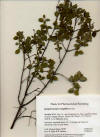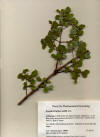|
Symphoricarpos albus
|
Symphoricarpos
longiflorus
|
|
Symphoricarpos mollis |
|
Symphoricarpos mollis |
Symphoricarpos mollis |
|
Symphoricarpos oreophilus
|
Symphoricarpos oreophilus
|
|
Symphoricarpos oreophilus .
|
Symphoricarpos rotundifolius
var. parishii |
|
Symphoricarpos rotundifolius
|
Symphoricarpos rotundifolius
|
|
Trees and Shrubs of Kern County (Dec 2012, Jan 2014, July 2014) Symphoricarpos. Deciduous shrubs, often spreading by underground shoots (rhizomes); leaves entire to toothed or partly lobed; flowers 1–many on terminal to axillary short axes, bell-shaped to funnelform, 4–5 lobed, enclosed by a similarly parted cupular calyx, fruit drupaceous: a baccate pyrenarium, snow white in color in our species, red or blue in others, with two pyrenes derived from a four-celled (locular) ovary in which only two develop, each with one pyrene. 16 species, 1 in southern China, 15 in North America including Mexico, 3 in Kern Co.; 6 reported with medicinal uses (Moerman), 7 species collected for the NCI antitumor screening since 2000, 32 extracts screened before 1980, none active. Several reports of poisoning from consumed fruit of S. albus. Taxonomy of the genus not clear among the floristic treatments and other references mentioned below.
1.
Flowers/fruits nodding or pendulous; corolla tube long funnelform, not
with an
2. Floral (corolla) tube
5× or more longer than corolla lobes; not in Kern
3. Flowers 10–13 mm; corolla generally funnelform, gradually
expanding
4. Plants wider than tall with long horizontal or recurving branches
to 1 m
1.
Flowers/fruits spreading to erect; corolla tube short, often with a
slight irregular
5. Terminal flowers/fruits in multiple clusters; corolla lobes
flaring widely,
6.
Plants with one or more erect simple to occasionally branched stems
Symphoricarpos albus
(L.) S.F. Blake var. laevigatus (Fernald) S.F. Blake 1914.
[Vaccinium album L. 1753; Symphoricarpos racemosum
Micheaux 1803; Symphoricarpos racemosus var. laevigatus
Fernald 1905; includes Symphoricarpos rivularis Suksdorf 1927]. Common
Snowberry. Shrub with one to many erect stems, occasionally
branched, usually 1–2 m high, spreading by
underground stems (rhizomes); branches slender with gray to brown
shredding bark; leaves broad elliptical to slightly wider below mid
region, 1–1.5× longer than wide, 1–5 cm long on petioles 2–4 mm, with ~6
pairs of lateral veins along a midrib, dull, without hairs or sparsely
hairy below, entire or irregularly and shallowly lobed near base, or in
the mid region, or upper half; flowering May–Aug; flowers white with
strong tinge of pink, in clusters of <18 in number at the ends of upper
axillary and terminal branchlets, bell-shaped, 5–7 mm, densely hairy on
the inside. Woodlands and forest communities below 4,000 ft; Coast
Ranges, Sierra Nevada, mountains of southern California, to Alaska and
Montana, the typical variety occurring further east to Quebec and south
to Virginia. Type from garden plants. Kern Co.: “Scarce” in
Douglas oak woodland of the Greenhorn Range, 2,800 ft near Lumreau Creek
Falls (Twisselmann), and Tiger Flat Campground (CCH). Used medicinally
by 20 or more native American tribes; root or root-bark, stem-bark, and
fruit most often applied for treating sores, cuts, or skin rashes, eye
problems, cold remedy, venereal diseases, diarrhea (Moerman).
Cultivated and naturalized in the U.S. Symphoricarpos mollis Nuttall 1841[Includes Symphoricarpos mollis var. acutus A. Gray 1884; Symphoricarpos hesperius G.N. Jones 1940]. Creeping snowberry. Shrub usually < 40 cm high with creeping branches 1–3 m long, rooting at nodes, the nodes and root crown often swollen; branches slender, reddish aging gray, with short curled hairs; leaves broad elliptical to slightly wider above or below mid region, 1–1.5× longer than wide, 1–3+ cm long on petioles 1–3 mm, with ~5 pairs of lateral veins along a midrib, the veins impressed above, raised below, dull, without hairs or with soft hairs on both surfaces, or only the lower surface hairy, entire or irregularly and shallowly lobed or toothed near base, or in the mid region, or upper half; flowering Apr–Jul; flowers white with strong tinge of pink, in pairs or clusters of <10 in number at the ends of upper axillary and terminal branchlets, shortly bell-shaped, 3–5 mm, hairy on the inside; ovary spherical. Forest communities, Southern British Columbia to Idaho, south to Sierra Juárez in Baja California, and east to New Mexico. Type from Santa Barbara, CA. Kern Co.: “Scarce” in understory of “yellow pine forest” in the Greenhorn Range and on Breckenridge Mt (Twisselmann), 549–2,200 m (CCH). Fruits used by one native American tribe in a wash for sore eyes (Moerman). For close-up images of S. mollis flowers see Santa Monica National Recreational website http://www.smmflowers.org/bloom/species/Symphoricarpos_mollis.htm
Variety acutus (JM1), which also has been recognized as a
species, has been distinguished by the more tapered leaves to base and
to apex (G. N. Jones 1940; Abrams in Ferris 1960; Munz and Keck 1959);
it was recognized to occur in the Coast Ranges and
Sierra Nevada as far south as Tehachapi Mts. in Kern Co. Also, among
plants occurring in the Coast Ranges from Humboldt Co. to southwestern British Columbia
and east to northern Idaho and the Klamath Region was S. hesperinus G. N. Jones 1940—distinguished by
the curly hairs on twigs as opposed to straight hairs in S. acutus. Symphoricarpos rotundifolius A. Gray 1853 var. rotundifolius Mountain snowberry. Rhizomatous shrub to 1.2 m; bark reddish aging gray and peeling, with short curled hairs; leaves broadly elliptical to slightly wider above or below mid region, 1–1.5× longer than wide, 1–2+ cm long on petioles 1–3 mm, with ~4 pairs of lateral veins strongly ascending along a midrib, without hairs or with soft hairs on both surfaces, or only the lower surface hairy, entire or irregularly and shallowly lobed or toothed near base, or in the mid region, or upper half; flowering Jun–Jul; flowers white to strong tinged with pink, mostly in pairs along lateral leafy branchlets, funnelform, 7–9 mm, hairless on the inside; ovary ellipsoid. Dry stony slopes, 4,000–10,000 ft in California (Munz & Keck 1959); south to northern Baja California; also Rocky Mts. from Colorado to New Mexico and Arizona (SEINet). Type from mountain slopes around copper mines, NM. Kern Co.: Badger Canyon in the Greenhorn Range, 1 mile below Badger Pass (CCH: C.N. Smith, 2 Jun 1940). Symphoricarpos rotundifolius was once more narrowly defined to occur only in New Mexico and Arizona by the densely hairy twigs, tubular funnelform corolla 8–10 mm long, anthers reaching only to the base of the corolla lobes, and soft hairy leaves, 1–3 cm by 0.6–1.9 cm (G. N. Jones 1940). The related S. oreophilus A. Gray 1873 was distinguished by the absence of hairs on twigs; however, its distinction has become blurred in later floristic treatments from widening the circumscription of S. rotundifolius, an earlier name. Symphoricarpos rotundifolius (var. rotundifolius), was not mentioned in the Intermountain Flora (Cronquist et al. 1984); also, S. oreophilus was not mentioned in JM1, JM2. The geographical distribution given in the treatments by Dempster for the Jepson Manuals imply S. oreophilus is a synonym; however, Symphoricarpos oreophilus has been distinguished by the lack of hairs on branches and leaves, and by the tubular funnelform flowers 11–13 mm (G. N. Jones 1940; Kearny & Peebles, Arizona Flora 1951; Cronquist et al. 1984), but the development of hairs on twigs is also highly variable (Hitchcock et al. 1959). In the Intermountain Flora, the species concept of S. oreophilus was broadened to include plants with hairy twigs under which three varieties were distinguished: var. parishii intricately branched to 1 m high, the upper branches horizontal to recurved, and with relatively small glaucous leaves; var. utahensis with ascending to erect braches, to 2 m high, further distinguished from var. oreophilus by its shorter tubular flowers, 6–10 mm, in contrast to the typical variety with longer flowers, 10–13 mm, occurring only in the Rocky Mountains (with outlying occurrences reported from near California on Pine Nut Mts. in Nevada and Hart Mt. Refuge in southern Oregon (SEINet)) in contrast to the other two more widely distributed varieties in the western U.S. The name S. vaccinioides Rydberg 1900 was applied to hairy plants occurring as far south as Fresno County in the Sierra Nevada (Munz & Keck 1959); however, its type was reportedly equal to that of S. utahensis Rydberg 1899 (Cronquist et al. 1984), which essentially corresponds to S. rotundifolius as defined on this web page. It appears that the shape of the corolla is the defining feature for the distinguishing S. oreophilus from S. rotundifolius west of the Rocky Mountains; the larger flowered plants occur mainly in the southern Rocky Mts. extending further south into northern Mexico. Symphoricarpos rotundifolius var. parishii (Symphoricarpos parishii Rydberg 1899) Dempster 1992. [S. oreophilus A. Gray 1873 var. parishii (Rydberg) Cronquist 1984]. Parish's snowberry. Distinguished by trailing habit, sparsely hairy twigs . Kern Co.: “Occasional in the Jeffrey pine forest from the Kern Plateau and Mt. Owns to Mt. Pinos, and in the Douglas oak woodland on the high slopes of the southern Tehachapi Mountains”, “heavily browsed by cattle, sheep, and deer” (Twisselmann), 1,440–2,590 m (CCH). Type from Mill Creek, San Bernardino Mts. Used by Navajo and Kayenta for sore throat (Moerman). The two varieties of S. rotundifolius are difficult to distinguish in Modoc Co. (JM2) and outside California (Cronquist et al. 1984). The transfer of variety parishii by Dempster from S. oreophilus to S. rotundifolius suggests that names for the species may be synonymous, but they are distinguished outside California at consortia websites (SEINet, Pacific Northwest)
|
|













